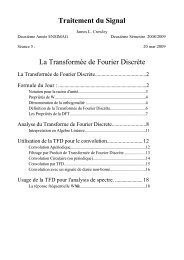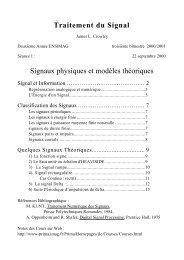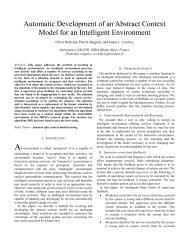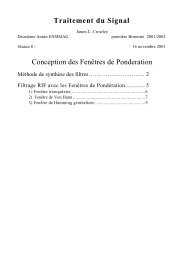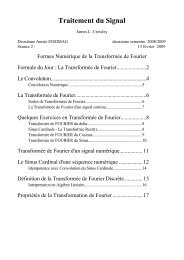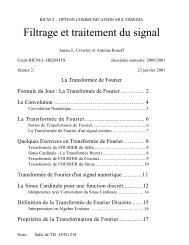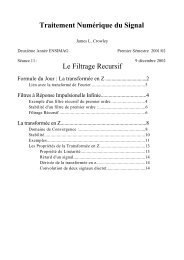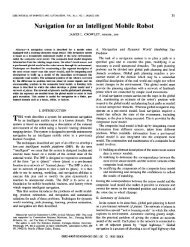1. Homogeneous Coordinates and Tensor Notation - PRIMA
1. Homogeneous Coordinates and Tensor Notation - PRIMA
1. Homogeneous Coordinates and Tensor Notation - PRIMA
You also want an ePaper? Increase the reach of your titles
YUMPU automatically turns print PDFs into web optimized ePapers that Google loves.
Coordonnées Homogènes Séance 1<br />
Image Analysis <strong>and</strong> Formation<br />
(Formation et Analyse d'Images)<br />
James L. Crowley<br />
ENSIMAG 3 - MMIS Option MIRV First Semester 2010/2011<br />
Lesson 1 27 sept 2010<br />
Lesson Outline:<br />
<strong>Homogeneous</strong> <strong>Coordinates</strong><br />
<strong>1.</strong> <strong>Homogeneous</strong> <strong>Coordinates</strong> <strong>and</strong> <strong>Tensor</strong> <strong>Notation</strong>..........2<br />
<strong>Tensor</strong> <strong>Notation</strong>: ......................................................................... 3<br />
2. Cross Products ..............................................................5<br />
Two point make a line................................................................. 5<br />
Two lines make a point ............................................................... 6<br />
1-1
Coordonnées Homogènes Séance 1<br />
<strong>1.</strong> <strong>Homogeneous</strong> <strong>Coordinates</strong> <strong>and</strong> <strong>Tensor</strong> <strong>Notation</strong><br />
<strong>Homogeneous</strong> coordinates allow us to express translation, rotation, scaling, <strong>and</strong><br />
projection all as matrix operations. The principle is to add an extra dimension to each<br />
vector.<br />
For example, points on a plane are expressed as:<br />
r<br />
P =<br />
" x%<br />
$ '<br />
y<br />
$<br />
'<br />
# 1&<br />
Similarly, points in 3D space become<br />
!<br />
r<br />
Q =<br />
" x%<br />
$ '<br />
$<br />
y<br />
'<br />
$ z'<br />
$ '<br />
# 1&<br />
! The line equation, ax+by+c=0 can be expressed as a simple product:<br />
r<br />
L r T P = a b c<br />
( )<br />
" x%<br />
$ '<br />
y<br />
$ ' = 0<br />
# 1&<br />
where<br />
r<br />
L T = a b c ( )<br />
!<br />
Similarly, for a plane equation: ax+by+cz+d=1: !<br />
r<br />
S r T P = a b c d<br />
( )<br />
" x%<br />
$ '<br />
$<br />
y<br />
' = 0 where<br />
$ z'<br />
$ '<br />
# 1&<br />
r<br />
S = a b c d<br />
( )<br />
!<br />
!<br />
!<br />
Note that in <strong>Homogeneous</strong> coordinates, all scalar multiplications are equivalent.<br />
" x%<br />
" x%<br />
$ '<br />
a<br />
y<br />
$ ' = b $ '<br />
y<br />
$ '<br />
# 1&<br />
# 1&<br />
Any vector can be expressed in "canonical" form by normalizing the last coefficient<br />
to <strong>1.</strong><br />
1-2
Coordonnées Homogènes Séance 1<br />
" ax%<br />
" ax /a%<br />
" x%<br />
$ '<br />
ay<br />
$ ' = $ '<br />
ay /a<br />
$ ' = $ '<br />
y<br />
$ '<br />
# a & # a/a & # 1&<br />
! Our camera model will have the form of a 3 x 4 matrix<br />
M s<br />
i<br />
=<br />
" m 11<br />
m 12<br />
m 13<br />
m 14<br />
%<br />
$<br />
'<br />
m 21<br />
m 22<br />
m 23<br />
m 24<br />
$<br />
'<br />
# m 31<br />
m 32<br />
m 33<br />
m 34 &<br />
!<br />
such that<br />
"<br />
$<br />
$<br />
$<br />
$<br />
$<br />
#<br />
%<br />
' "<br />
' $<br />
' =<br />
1 ' $<br />
'<br />
#<br />
&<br />
q 1<br />
q3<br />
q 2<br />
q3<br />
q 1<br />
q 2<br />
q 3<br />
%<br />
'<br />
' = r i<br />
Q = M s<br />
P r<br />
=<br />
&<br />
" x<br />
" m 11<br />
m 12<br />
m 13<br />
m 14<br />
% s<br />
%<br />
$ '<br />
$<br />
'<br />
m 21<br />
m 22<br />
m 23<br />
m $<br />
y s '<br />
24<br />
$<br />
' $ z s<br />
'<br />
# m 31<br />
m 32<br />
m 33<br />
m 34 & $ '<br />
# 1 &<br />
! We can express this in "canonical form" by dividing out the last coefficient:<br />
M s<br />
i<br />
=<br />
" m 11<br />
m 12<br />
m 13<br />
m 14<br />
%<br />
$<br />
'<br />
m 21<br />
m 22<br />
m 23<br />
m 24<br />
$<br />
'<br />
# m 31<br />
m 32<br />
m 33<br />
1 &<br />
!<br />
!<br />
Notice that this gives 11 coefficients. This corresponds to our 11 parameters. The<br />
Rank of M is 1<strong>1.</strong><br />
<strong>Tensor</strong> <strong>Notation</strong>:<br />
In tensor notation, the sign " → " is remplaced by subscripts <strong>and</strong> superscripts.<br />
A super-script signifies a column vector.<br />
r<br />
For example the point P is P i<br />
The line<br />
"<br />
P i $<br />
=<br />
$<br />
#<br />
p 1<br />
p 2<br />
p 3<br />
%<br />
'<br />
!<br />
'<br />
&<br />
r<br />
L T is L i = (l 1 , l 2 , l 3 )<br />
!<br />
1-3
Coordonnées Homogènes Séance 1<br />
A matrix is a line matrix of column matrices (or a column of line matrices)<br />
"<br />
$<br />
M j i<br />
= $<br />
$<br />
#<br />
m<br />
1<br />
1<br />
m<br />
1<br />
2<br />
m<br />
1<br />
3<br />
m 2<br />
1<br />
m<br />
2<br />
2<br />
m<br />
2<br />
3<br />
m 3<br />
1<br />
m<br />
3<br />
2<br />
m<br />
3<br />
3<br />
%<br />
'<br />
'<br />
'<br />
&<br />
! When homogeneous coordinates are used to represent transforms, these indices can<br />
be used to indicate the reference frame.<br />
For example: A transformation from the scene "s" to the image "i"<br />
is a 3 x 4 matrix M<br />
"<br />
$<br />
M i s<br />
= $<br />
$<br />
#<br />
m 1<br />
1<br />
m 1<br />
2<br />
m 1<br />
3<br />
m 2<br />
1<br />
m 2<br />
2<br />
m 2<br />
3<br />
m 3<br />
1<br />
m 3<br />
2<br />
m 3<br />
3<br />
%<br />
'<br />
'<br />
1<br />
'<br />
&<br />
m 4<br />
1<br />
m 4<br />
2<br />
The sub/super scripts indicate the source <strong>and</strong> destination reference frames.<br />
i<br />
M s<br />
is ! a transformation from "S" (Scene) to "i" (image).<br />
!<br />
Einstein summation convention:<br />
The summation symbol is implicit when a superscript adn subscript have the same<br />
letter.<br />
L i P i = l 1 p 1 + l 2 p 2 + l 3 p 3<br />
for a matrix <strong>and</strong> vector, this gives a new vector:<br />
p j = T i j p i<br />
! This example transforms the point p in reference i to a point p in reference j.<br />
1-4
!<br />
Coordonnées Homogènes Séance 1<br />
2. Cross Products<br />
Two point make a line<br />
A line is a set of points that satisfies a constraint. The constraint is the line equation.<br />
r<br />
L r T P = ax + by + c = 0<br />
The constraint can be determined from any two points on the line P 1 = (x 1 ,y 1 ) <strong>and</strong><br />
P 2 = (x 2 ,y 2 ).<br />
Classically, we subsitute P 1 <strong>and</strong> P 2 in the line equation to obtain two equations<br />
ax 1 + by 1 + c = 0<br />
ax 2 + by 2 + c = 0<br />
We then solve the two equations for a, b <strong>and</strong> c. This should give :<br />
a = (y 1 –y 2 ) b = (x 2 – x 1 )<br />
c = –(a x 1 – b y 1 ) = – x 1 (y 1 –y 2 )– y 1 (x 2 – x 1 ) = x 1 y 2 +x 2 y 1<br />
if we normalize such that || (a, b) || = 1 then<br />
d = ax + by + c<br />
where d is a signed perpendicular distance from the line, positive to the left <strong>and</strong><br />
negative to the right.<br />
In fact the constraint imposed by the line can be discovered from the cross product of<br />
the two points:<br />
L T = ⎜ ⎜⎛ a<br />
b ⎝ c⎠ ⎟⎟⎞<br />
= P → 1 x P → 2 = ⎜ ⎜⎛ 0 –1 y 1 x 2<br />
1 0 –x 1<br />
⎝ –y ⎠ ⎟⎟⎞<br />
1 x 1 0 ⎝ ⎜⎜⎛ y 2<br />
⎠ ⎟⎟⎞ = ⎜ ⎜⎛ y 1 –y 2<br />
x 2 –x 1<br />
1 ⎝ x ⎠ ⎟⎟⎞<br />
1 y 2 –x 2 y 1<br />
This is equivalent to a setting the determinant to zero with free variables in one of the<br />
rows.<br />
x y 1<br />
x 1<br />
y 1<br />
1 = x(y 1<br />
– y 2<br />
)+ y(x 2<br />
– x 1<br />
)+ x 1<br />
y 2<br />
– x 2<br />
y 1<br />
= 0<br />
x 2<br />
y 2<br />
1<br />
!<br />
1-5
Coordonnées Homogènes Séance 1<br />
This is a simple example of a general principle that can be useful in higher<br />
dimensions.<br />
Two lines make a point<br />
There is a perfect duality between points <strong>and</strong> lines. So naturally, two lines make a<br />
point.<br />
Given non-parallel lines L <strong>and</strong> M.<br />
L: a 1<br />
x + b 1<br />
y + c 1<br />
= 0<br />
<strong>and</strong> M : a 2<br />
x + b 2<br />
y + c 2<br />
= 0.<br />
In classic notation L T = (a 1<br />
, b 1<br />
, c 1 ) et M T =(a 2<br />
, b 2<br />
, c 2 )<br />
The unique point is<br />
y = c 1a 2<br />
" c 2<br />
a 1<br />
c 1<br />
a 2<br />
" c 2<br />
a 1<br />
The cross product is<br />
!<br />
P → = L → x M → =<br />
x = b 1c 2<br />
" b 2<br />
c 1<br />
a 1<br />
b 2<br />
" a 2<br />
b 1<br />
!<br />
v<br />
P = L v<br />
" M v # 0 –c 1<br />
b 1<br />
&#<br />
%<br />
(%<br />
=<br />
c 1<br />
0 –a 1<br />
%<br />
(%<br />
$ –b 1<br />
a 1<br />
0 ' $<br />
a 2<br />
b 2<br />
c 2<br />
& #–c 1<br />
b 2<br />
+ b 1<br />
c 2<br />
& b 1 c 2 –c 1 b 2<br />
(<br />
( = % (<br />
c 1<br />
a 2<br />
– a 1<br />
c 2<br />
= % ( ⎝ ⎜⎜⎛ c 1 a 2 –a 1 c 2<br />
a ⎠ ⎟⎟⎞<br />
' $ –a 2<br />
b 1<br />
+ a 1<br />
b 1 b 2 –a 2 b 1<br />
2 '<br />
as before the cross ! product is equivalent to setting a determinant to zero. In this case:<br />
a b c<br />
a 1<br />
b 1<br />
c 1<br />
= a(b 1<br />
c 2<br />
– c 1<br />
b 2<br />
)+ b(c 1<br />
a 2<br />
– a 1<br />
c 2<br />
)+ c(a 1<br />
b 2<br />
– b 1<br />
a 2<br />
) = 0<br />
a 2<br />
b 2<br />
c 2<br />
!<br />
The unique point is<br />
x = b 1 c 2 " b 2 c 1<br />
a 1<br />
b 2<br />
" a 2<br />
b 1<br />
!<br />
y = c 1 a 2 " c 2 a 1<br />
c 1<br />
a 2<br />
" c 2<br />
a 1<br />
!<br />
1-6



